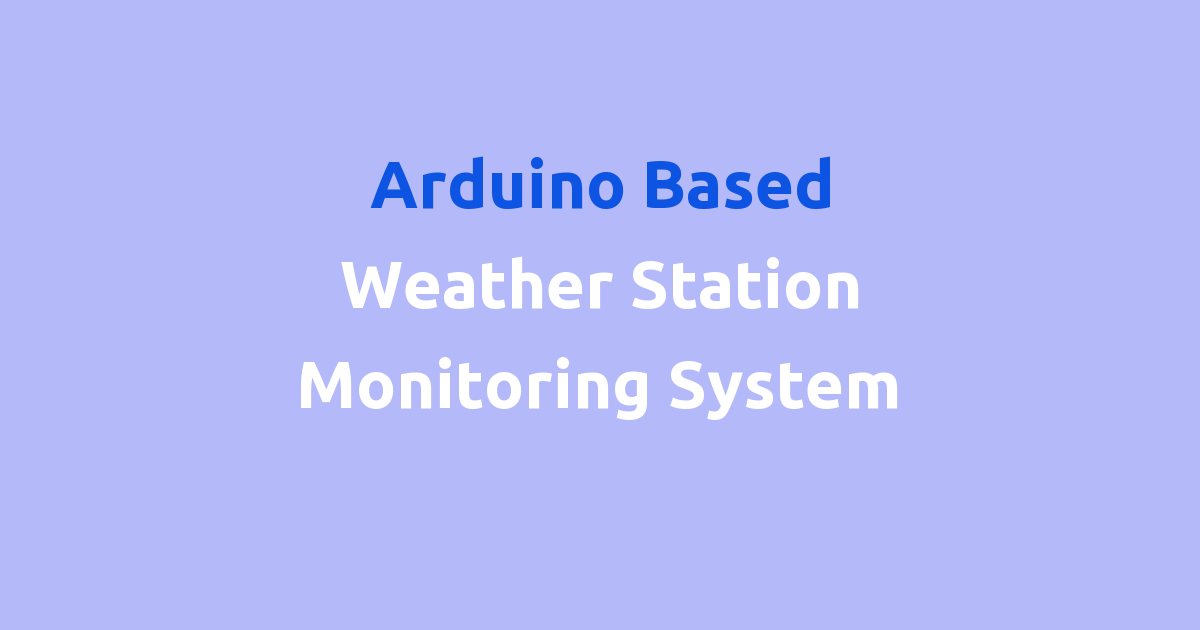Weather station monitoring system based on Arduino.
Arduino Based Weather Station Monitoring System
Introduction:
Weather stations are an essential tool for monitoring and forecasting weather conditions. They provide valuable information for a wide range of applications, including agriculture, aviation, and disaster preparedness. In recent years, there has been a growing interest in developing weather stations that are low-cost, reliable, and easy to use. One popular platform for building weather stations is the Arduino microcontroller. Arduino is an open-source electronics platform that is widely used for developing interactive projects. In this project, we propose an Arduino-based weather station monitoring system that can be used to monitor weather conditions in real-time.
Problem Statement:
Traditional weather stations are often expensive and require professional installation and maintenance. They may also lack the flexibility to integrate with other systems or to be easily customized for specific applications. In addition, existing weather stations may not provide accurate or up-to-date information, which can limit their usefulness for certain applications. Our goal is to develop a weather station monitoring system that is low-cost, easy to use, and highly customizable. This system will provide accurate and real-time weather data that can be accessed remotely from any location.
Existing System:
The existing weather station monitoring systems are usually large, bulky, and expensive. They require specialized equipment and knowledge to set up and maintain. In addition, they may not be easily customizable or scalable to meet the specific needs of different users. The data collected by these systems may also be limited in scope or accuracy. Overall, the existing weather station monitoring systems are not user-friendly or cost-effective for many applications.
Disadvantages:
Some of the disadvantages of the existing weather station monitoring systems include:
– High cost: Traditional weather stations can be prohibitively expensive for many users, especially individuals or small organizations.
– Limited accessibility: Weather data collected by traditional weather stations may not be easily accessible or usable for remote monitoring.
– Lack of customization: Existing weather station systems may not be easily customizable or scalable to meet the specific needs of different users.
– Maintenance: Traditional weather stations require regular maintenance and calibration to ensure accuracy and reliability.
Proposed System:
Our proposed weather station monitoring system will address these limitations by providing a low-cost, easy-to-use, and customizable solution. The system will be based on Arduino microcontrollers, which are affordable, widely available, and easy to program. We will develop a set of sensors for measuring temperature, humidity, pressure, and wind speed, which will be connected to the Arduino board. The data collected by the sensors will be transmitted wirelessly to a central server for storage and analysis. Users will be able to access the weather data through a web interface or mobile app, allowing them to monitor conditions in real-time from any location.
Advantages:
Some of the advantages of our proposed weather station monitoring system include:
– Low cost: Using Arduino microcontrollers and off-the-shelf sensors will significantly reduce the cost of the weather station system.
– Easy to use: The system will be designed with a user-friendly interface that is easy to set up and customize for different applications.
– Real-time monitoring: Users will be able to access weather data in real-time, allowing them to make informed decisions based on up-to-date information.
– Customizable: The system will be highly customizable, allowing users to add or remove sensors based on their specific needs.
– Remote accessibility: Weather data will be accessible remotely, making it easy for users to monitor conditions from any location.
Features:
Our weather station monitoring system will include the following features:
– Temperature sensor: Measures the temperature of the environment.
– Humidity sensor: Measures the humidity level in the air.
– Pressure sensor: Measures the atmospheric pressure.
– Wind speed sensor: Measures the speed of the wind.
– Wireless transmission: Data collected by the sensors will be transmitted wirelessly to a central server.
– Web interface: Users can access weather data through a web interface for easy monitoring.
– Mobile app: Users can also access weather data through a mobile app for on-the-go monitoring.
Conclusion:
In conclusion, our Arduino-based weather station monitoring system offers a low-cost, easy-to-use, and customizable solution for monitoring weather conditions. By using Arduino microcontrollers and off-the-shelf sensors, we have created a system that is affordable and accessible to a wide range of users. The system provides real-time weather data that can be accessed remotely, allowing users to make informed decisions based on up-to-date information. We believe that our weather station monitoring system has the potential to revolutionize the way weather data is collected and used for various applications.

